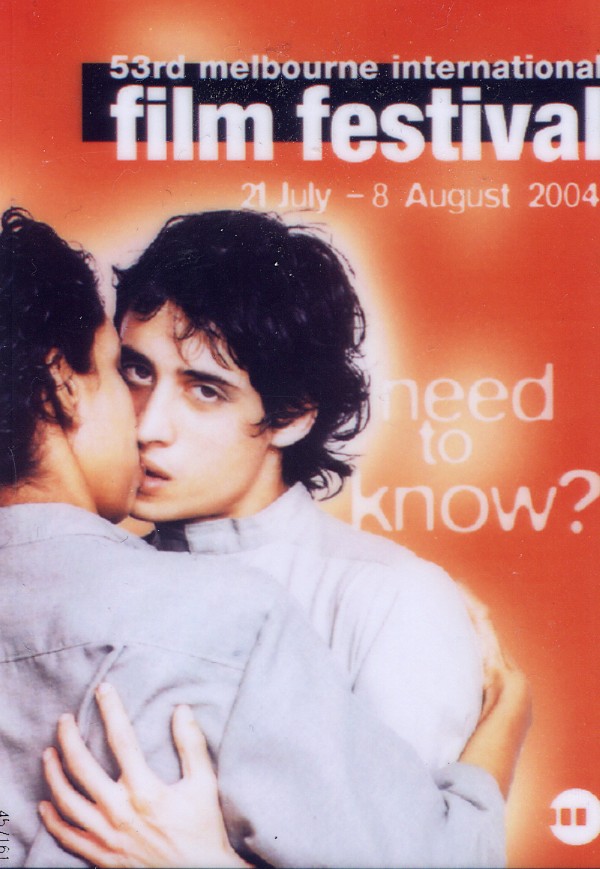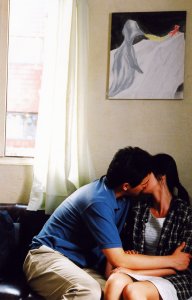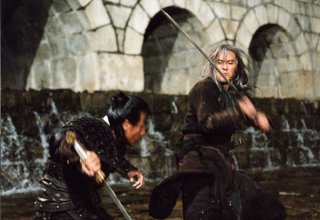2004 Melbourne International Film Festival Report:
Korean Films at the MIFF
by Boris Trbic
Melbourne International Film Festival has played a major role in
popularising Korean film in Australia. Four years ago when eleven Korean
films were first introduced as part of the Regional Focus programme,
they attracted Korean ex-pats and students, and local film buffs
interested in new tendencies in Asian cinema. Soon after, with the
arrival of Kim Ki-duk's movies (he was a special guest of the Festival
 in 2003 along with the Iranian director, Abbas Kiarostami), Korean films
started steadily gaining popularity and became one of the most
significantly represented cinematographies at the MIFF. Australian film
buffs were, in the past three years able to familiarise themselves with
a range of Korean films, from low budget digital features like Camels
and Tears, to arthouse films, Turning Gate and Old Boy, to the
commercial blockbusters, Joint Security Area, Silmido or
Sword in the Moon. It might be interesting to point out that 8849, a
short film of Go Young-min was screened at the Opening night of MIFF
2002. This was followed by discussions about the Korean film industry
that enabled a better understanding of Korean popular and art house
cinema, similarities, differences and links with other cinematographies
in the region.
in 2003 along with the Iranian director, Abbas Kiarostami), Korean films
started steadily gaining popularity and became one of the most
significantly represented cinematographies at the MIFF. Australian film
buffs were, in the past three years able to familiarise themselves with
a range of Korean films, from low budget digital features like Camels
and Tears, to arthouse films, Turning Gate and Old Boy, to the
commercial blockbusters, Joint Security Area, Silmido or
Sword in the Moon. It might be interesting to point out that 8849, a
short film of Go Young-min was screened at the Opening night of MIFF
2002. This was followed by discussions about the Korean film industry
that enabled a better understanding of Korean popular and art house
cinema, similarities, differences and links with other cinematographies
in the region.
Korean features were screened in the Regional Focus programme of the
MIFF, alongside Chinese, Japanese, Hong Kong, Thai and Taiwanese films.
This year, films screened in this programme included: Old Boy (2003), Woman is
the Future of Man (2004), Samaritan Girl (2004), Spring, Summer, Fall, Winter... and
Spring (2003), Sword in the Moon (2003), A Tale of Two Sisters (2003), Natural City (2003), If You
Were Me (2003), Silmido (2003) (soon to be released in Australia) and A Good Lawyer's Wife (2003).
Introduced by the director, Park Chan-wook (Joint Security Area MIFF
2001, Sympathy for Mr Vengeance 2003), Old Boy closed the festival on
the 8th of August. The intricate narrative about a seemingly innocent man
imprisoned for fifteen years and released without explanation, focuses
on the themes of guilt and revenge and emerged as one of the most
exciting and provocative films in 2003. Park Chan-wook's protagonists
are obsessed by the irretrievable events that scarred them for life,
stranded in a seemingly impenetrable labyrinth of love, deceit and
revenge. The gloom, dilapidation and uncompromising directorial style
suggest parallels with the films of David Lynch. However, it would be
difficult to ignore the social, cultural and political subtexts in this
film that are profoundly and specifically Korean. The Executive Director
of the Festival, James Hewison drew the audience's attention to the
scenes of senseless, myopic violence, prior to the screening.
Nevertheless, even these, starkly naturalistic moments, have a
particular place in Park Chan-wook's narrative. In this surreal love
story, each emotion is boiled down to its most shocking, exaggerated
core.
 Melbourne viewers would have certainly missed out on one important
aspect of this film; the star status of the male protagonists. However,
the technical and stylistic details, the positioning of the camera and
the rapid cutting in key scenes gave the audience a hint of it.
Melbourne viewers would have certainly missed out on one important
aspect of this film; the star status of the male protagonists. However,
the technical and stylistic details, the positioning of the camera and
the rapid cutting in key scenes gave the audience a hint of it.
Hong Sang-soo's Woman is the Future of Man (pictured left) evokes correspondences with
his previous films seen in Australia, Virgin Stripped Bare by her
Bachelors (2001) and Turning Gate (2003). Hong Sang-soo regards his
protagonists' relationships with scepticism, and presents the audience
with a complex, multilayered narrative about friendship, love and
divided loyalties. The director has immense understanding for his
characters, but no perceptible empathy for the social forces that make
them act in the way they do. This is particularly characteristic of his
male characters' treatment of women. The frugal, poetic dialogues
between his urban loners and the long pauses in their conversations
evoke a sense of loneliness, confusion, uncertainty and temps perdu.
Since their first screenings at the MIFF, Hong Sang soo's films have
developed a devoted band of admirers. One would think it is time for a
retrospective.
Im Sang-soo's second film Tears was shown at MIFF 2001 and focused on
the life of Seoul teenagers growing up in the urban slums. A Good
Lawyer's Wife offers an interesting insight into the frustrations,
dilemmas and disappointments of Korean middle class. The director's
portrayal of the two confused, insecure and ultimately narcissistic
individuals, suggests that urban alienation and loneliness still remain
in the focus of his attention.
This film departed from the usual framework of drama, centered on a
couple trapped by middle class morality. The director expanded his
narrative initially focusing on the teenager's quest for freedom, using
the elements of comedy. The narrative gradually absorbs a strangely
compelling subplot focusing on the devastating relationship between the
elderly parents. Father's delirium unveils a horrifying trauma of his
childhood and youth, matched by his wife's bitter reminiscences and
sense of emotional unease of the young couple. A murder in the final
stages of the film emerges as a stark reflection of the middle class
couple's life. They are seen acting in ways which are morally false and
entering a series of compromises, with disastrous consequences.
 Sword in the Moon (pictured right) was shown alongside other exhilarating swordplay
films, Warriors of Heaven and Earth (He Ping, China/Hong Kong), Hero
(Zhang Yimou, China) and Zatoichi (Takeshi Kitano, Japan) and a
programme of Chang Cheh's movies from Hong Kong. Kim Eui-suk's film, straight from Un
Certain Regard in Cannes, provides exceptional entertainment,
breathtaking scenes, exquisite photography and solid performances.
Seeing these films in the festival atmosphere, one tends to lose out on
their generic specificities; the wu xia pian elements in Hero, the
theatrical subtext of Kitano's films (Bunraky in Dolls, the dancing
finale in Zaitochi) and ultimately the stylistic references (Milius,
Fleischer) in Sword in the Moon.
Sword in the Moon (pictured right) was shown alongside other exhilarating swordplay
films, Warriors of Heaven and Earth (He Ping, China/Hong Kong), Hero
(Zhang Yimou, China) and Zatoichi (Takeshi Kitano, Japan) and a
programme of Chang Cheh's movies from Hong Kong. Kim Eui-suk's film, straight from Un
Certain Regard in Cannes, provides exceptional entertainment,
breathtaking scenes, exquisite photography and solid performances.
Seeing these films in the festival atmosphere, one tends to lose out on
their generic specificities; the wu xia pian elements in Hero, the
theatrical subtext of Kitano's films (Bunraky in Dolls, the dancing
finale in Zaitochi) and ultimately the stylistic references (Milius,
Fleischer) in Sword in the Moon.
One would argue that Korean film in Australia will, in the foreseeable
future, remain centered on festivals like MIFF. The emergence of Madman
Cinema programme Eastern Eye, that includes Japanese, Korean (Silmido),
Thai, Chinese and Hong Kong films is a step in the opposite direction. A
series of programmes, retrospectives and individual screenings organised
by cultural centres, distributors and departments of Asian/Cinema
Studies would certainly enable Korean film fans to remain in touch with
this vibrant filmography.
Other highlights
From the films in the official selection, one should mention the
screenings of Gatlif's Exiles, Rohmer's Triple Agent, Rivette's The
Story of Marie and Julien, Kusturica's Life is a Miracle and
Colagrande's Open My Heart as well as the retrospective of Thai
Breakers: New Cinema from Thailand. Pen-ek Ratanaruang (6ixtynin9,
Mon-Rak Transistor, Last Life in the Universe) was a guest of the
Festival along with the Australian born director of photography
Christopher Doyle. Doyle opened his photographic exhibition, "Why I am
not a Painter," with stills from Wong Kar Wai's, Ratanaruang's, Noyce's
and Zhang's films.
The documentaries screened at this year's MIFF include Michael Moore's
blockbuster Fahrenheit 9/11, and a series of complex, revealing and
inspiring films from Iran, Israel, Palestine, UK and Australia, that
enjoyed less media attention but were well received with the audiences.
These included the Elia Suleimani programme, a selection of short
Iranian documentaries, The Man Who Stole My Mother's Face (Australia,
winner of Tribeca), Noon Gun, Bedroom Radio and The Boy Who Plays on the
Buddhas of Bamiyan (UK) and the Israeli/French documentary Wall.
Boris Trbic is a Melbourne writer and film critic. He has written about
film in Sensesofcinema.com, Metro, Australian Screen Education and
other Australian and overseas publications. He has worked as a member of
the Documentary Panel at the Melbourne International Film Festival (2000-2004).